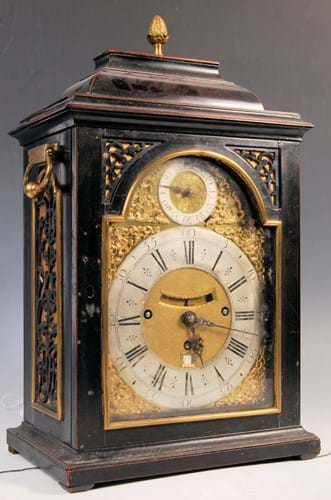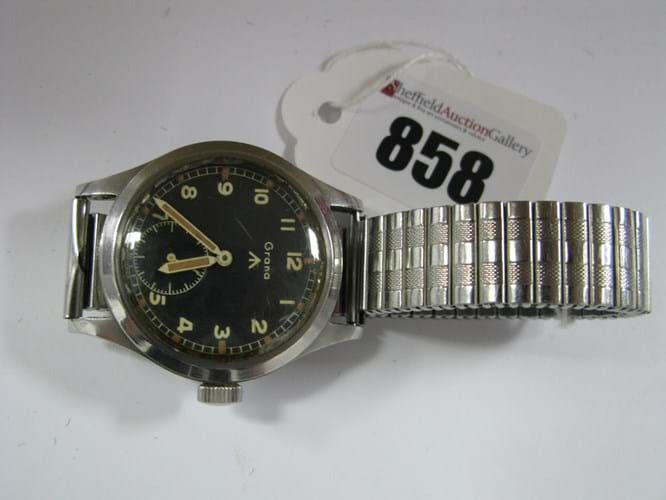1. Queen Anne bracket clock – £15,000
Born c.1671, Francis Robinson ranks among the finest London clockmakers of the late Golden Age period. Apprenticed to Henry Jones and the de facto lead worker in Jones’ workshop by the early 1690s, he was made free in 1707 and rose through the Clockmakers' Company to become Master in 1725.
Two years later he was made Clockmaker in Ordinary to the King receiving an annual stipend of £150 at his workshop at Inner Temple Lane.
This ‘rare and important’ 20in (50cm) Queen Anne bracket clock, above, signed to the pendulum aperture, was a new discovery and in fine unrestored condition. Housed in a typical fret-carved case c.1710 was a large verge movement striking on multiple bells and a music cylinder playing two patriotic numbers: Henry Purcell’s Britain Strike Home! and The King.
It emerged at East Bristol Auctions on October 29 with an estimate of £4000-6000 from a family who had no idea of its commercial potential. It attracted four phone bidders before selling to an online bidder via thesaleroom.com for £15,000.
2. Godwin ebonised table – £4500
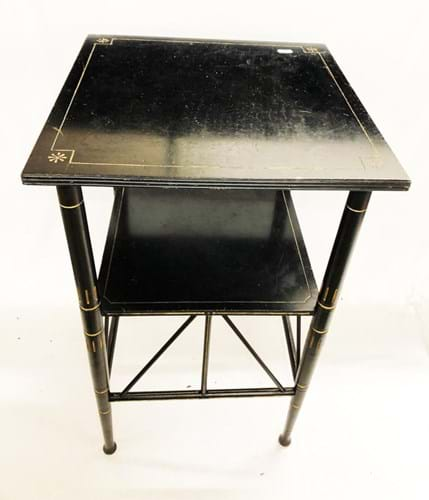
An Edward William Godwin ‘Anglo-Japanese’ ebonised table made by Gillows – £4500 at Kent Auction Galleries.
Even during his lifetime, Edward William Godwin complained that ebonised tables to his textbook ‘Anglo-Japanese’ design c.1867-68 were being copied by a number of different manufacturers.
Many of these inferior ‘lookalikes’ now appear for sale and sell for bargain sums of around £100-300 apiece.
However a table with a much closer connection with Godwin’s original design is a very different commercial proposition. They were made with Godwin’s approval by Collinson & Lock, William Watt and Gillows.
This one, marked 'Gillows No. 713’ emerged for sale at Kent Auction Galleries in Folkestone on October 26.
Estimated at £150-300, it sold at £4500.
3. Chinese export porcelain set – £19,000
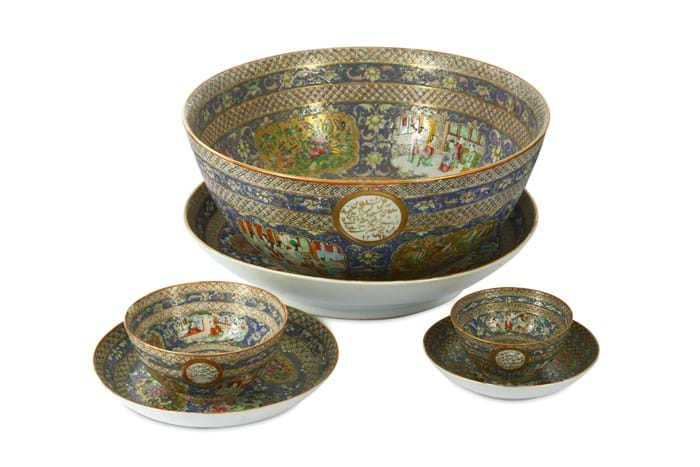
A set of late 19th century Chinese export bowls and saucers made for the Qajar prince – £19,000 at Chiswick Auctions.
This group of late 19th century Chinese export bowls and saucers were made for the Middle Eastern market – specifically for the Qajar prince Mas'ud Mirza Zill al-Sultan (1850-1918). Two of the bowls are dated 1297AH for 1879-80. The largest at 15in (37cm) across is dated 1301 AH (1883-4).
Alongside typical famille rose decoration is the unusual grey-mauve ground and a gilt inscription in Persian that identifies them as part of the large service commissioned by the prince, the eldest son of the ruling Shah Naser al-Din Shah (1831-96). As his mother was a commoner Mas'ud Mirza was excluded from the Qajar throne and instead operated as governor of Isfahan from 1866-99. His title Zill al-Sultan means the Shadow of the King.
Several porcelain sets and vessels from his service have appeared on the London auction market in recent years. This group of pieces were sold by Chiswick Auctions as part of a sale of Islamic art in west London on October 25.
Estimated at £6000-8000, they took £19,000.
4. Roman glass collection – £3600
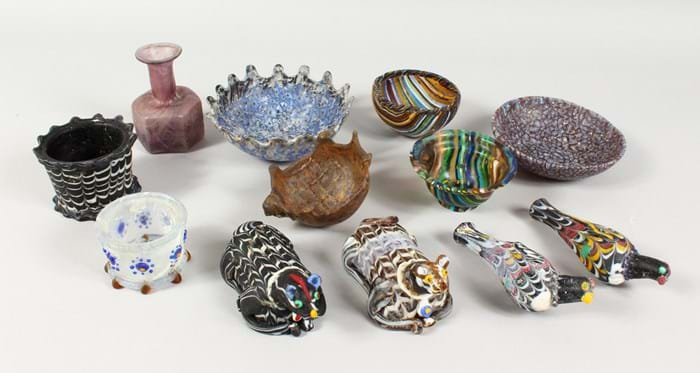
A collection of 11 Roman glass bowls and jars, models of birds and animals and a tortoise shaped bowl – £3600 at John Nicholson.
The latest sale at John Nicholson in Haslemere included a substantial collection of ancient coloured glassware – more than 60 pieces sold across half a dozen group lots.
Although the cataloguing was brief, most were Roman bottles and bowls associated with personal adornment and drinking from the 1st century BC to the 1st century AD – unguentaria for perfume, alabastron flasks for oils and patella cups for ointments or drinking. Others appeared to be ancient Persian glass (from the 6th to 4th century BC) and Greek vessels from the 4th to 1st century BC.
Together they displayed an array of ancient glassmaking techniques including marbling, banding, mosaic work, core-forming and mould-blowing.
Among the high-status novelties were bottles with polychrome trailed decoration modelled as birds and rodents and a bowl modelled as a tortoise lying on its back. A selection of mould-blown flasks included a red ‘agate’ vessel modelled as the head of a beard man and others in cobalt blue glass formed as bunches of grapes. Most displayed the characteristics of glassware that had been buried.
The estimates at the auction on October 24 of £200-300 per lot of 10 or more items were modest at best. Although bidding on each lot reached between £2800-3600, a close inspection of the individual pieces suggests many could individually merit four-figure sums. There could be some mileage left.
5. ‘Dirty Dozen’ wristwatch – £12,000
This unassuming Grana military issue c.1945 forms part of the so-called ‘Dirty Dozen’ wristwatches made by 12 Swiss manufacturers for the British army. As perhaps as few as 1500 were made by this otherwise routine maker, it is considered the hardest to find of the Dozen.
These Grana watches sold at auction in the past decade have typically sold at prices ranging from £3500-£5500. However, in May 2018 one was sold by Shropshire firm Trevanion and Dean for what was deemed a record price of £9000.
This fine example (with later bracelet) consigned for sale at Sheffield Auction Galleries on October 25 did even better selling well above the £3500-4500 estimate for £12,000.


